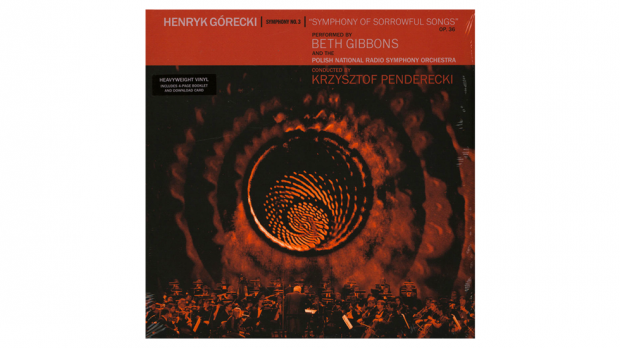
Beth Gibbons w/ Krzysztof Pendericki & the Polish National Radio Symphony Orchestra
Henryck Gorecki: Symphony No. 3 (Symphony of Sorrowful Songs)
Domino
An unusual outing for Beth Gibbons of Portishead fame here, as she delivers a straight-up reading of a modern classical music piece with the Polish National Radio Symphony Orchestra. Of course, “straight-up” is anything but, as the piece requires an incredible amount of effort, both emotionally and in terms of technique, to successfully pull it off. The recording is of a concert that took place in late 2014, along with other popular musicians on the program such as Jonny Greenwood from Radiohead and Bryce Dessner from The National.
Singing the piece was quite an accomplishment for Gibbons, as she did not know Polish and is not a natural soprano, the register of voice for which the work was written. But working with a vocal coach and investing herself fully into the performance, the hard work paid off. Gibbons’s singing on Symphony of Sorrowful Songs is a stirring statement to her vocal range and emotional depth, and pushes her oeuvre to new territories not imagined from the trip hop singer.
Originally composed and first performed in the late 1970s, Gorecki’s Third Symphony was largely met with indifference or negative reviews. It was highly regarded in Poland, however, as it incorporated reworkings of folk melodies from the Silesia region and touched upon nationalistic, religious and familial themes. The work found a second life in the 1980s through various recordings on the new compact disc format, as CDs had just begun to take off commercially with classical audiophiles snapping up albums in the new digital format. Symphony of Sorrowful Songs is now by far Gorecki’s most well known piece, despite most of his years writing more avant-garde works.
The music is carried almost entirely on over 40 stringed instruments, led by Krzysztof Penderecki. The music rises and falls with the swelling of the strings, the repetition creating a hypnotic effect. These strings are the heart of the piece, hovering in some strange space that hold an unusual and powerful sway over the emotions. Deft use of occasional keystrokes on the piano and harp create a plaintive sound which provide a kind of signpost for the nebulous, soaring strings.
Then there’s the voice: emotional, frayed, raw. Compared to other recordings, Gibbons brings a more earthy interpretation, perhaps in keeping with the pop-classical fusion fare on offer here.
The long first movement builds slowly, with the singing first coming in around the 12-minute mark. When the voice does break in, it’s a somewhat startling, a very high-pitched and piercing voice. Fans of Portishead may be taken aback at what sounds like crystal-shattering notes, but sticking with the piece is worth it. The first movement is based on a folk song with Mary speaking to Jesus on the cross, to share his pain with her, so there’s plenty of emotion on hand here.
The second movement is the shortest of the three at only eight minutes, and takes its inspiration from writing Gorecki saw on a wall in the cell of a Gestapo prison by an 18 year old woman, wherein she tells her mother not to worry for her. Again, another heavy, “sorrowful song”.
The third movement is based on a Silesian folk song, with a mother crying in anguish over the loss of her son in the uprisings post-WWI, a point of national pride for Poles. The singing is very intense and pretty heartbreaking stuff to listen to, with Gibbons’ voice carrying the emotions admirably. But during the middle part of the movement, the music somewhat resolves itself, along with the mother’s resignation to her son’s death, who asks “Oh, sing for him, God’s little songbirds” so that he may rest in peace. (The words in Polish are “Ej, cwierkejcie mu tam, wy ptosecki boze”, giving you an idea of the challenges Gibbons faced.) Here the melody turns to something profound and beautiful, with the strings swelling with feeling towards an emotional peak. The final part recapitulates the opening singing briefly, playing out instrumentally for a stirring conclusion.
The coming together of the different artists results in a profoundly moving work, regardless of whether Gibbons is giving herself a post- (or at least between-works) Portishead challenge, or if Pendericki and the Polish symphony here is merely ‘slumming’ with a pop star (not unlike what WASO and countless other orchestras do when playing popular pieces, whether its Nirvana or Harry Potter). Gibbons lends a fresh interpretation to the highly popular piece, and in turn exposes it to people who would not otherwise hear such classical compositions. A haunting and powerful symphony, this recording has to be listened to immersively to feel the majesty in Gorecki’s piece, the mighty orchestra led by Pendericki and the heart-rending voice of Gibbons.
PAUL DOUGHTY